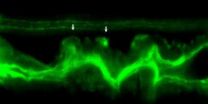(Press-News.org) This year's mild winter and early spring were a bonanza for tick populations in the eastern United States. Reports of tick-borne disease rose fast.
While Lyme disease is the most common tick-borne disease in the Northeast and Upper Midwest, new research results emphasize that it is not the greatest cause for concern in most Southeastern states.
The findings are published today in a paper in the journal Zoonoses and Public Health.
The majority of human-biting ticks in the North--members of the blacklegged tick species--cause Lyme disease, but these same ticks do not commonly bite humans south of mid-Virginia.
Biologist Graham Hickling of the University of Tennessee, co-author of the paper, says many patients in Southeastern states, who become sick from a tick-bite, assume they have Lyme disease, but the odds of that being the case are low.
"Ticks in the eastern U.S. collectively carry more than a dozen agents that can cause human disease," says Hickling.
"Here in Tennessee we regularly collect lone star ticks that test positive for Ehrlichia, [a tick-borne bacterial infection]. Lone stars are an aggressive species that account for most of the human bites that we see in this region. So ehrlichiosis has to be a big concern, yet most people have never heard of it."
In contrast, says Hickling, there have been no confirmed reports to date of the Lyme disease pathogen among the sparse populations of blacklegged ticks found in Tennessee.
"The Southeast is dominated by different tick species than the ones that attack humans in the North," says Ellen Stromdahl, an entomologist at the U.S. Army Public Health Command and lead author of the paper.
"The lone star tick is by far the most abundant tick in the Southeast, and which species of tick bites you is critical because different ticks carry different diseases. In the Southeast you are unlikely to be bitten by the blacklegged ticks that spread Lyme disease," Stromdahl says.
Most bites in the Southeast are from the tick species that spread spotted fever rickettsiosis and ehrlichiosis, but not Lyme disease.
A complicating factor for public health officials is that tick species are on the move, as wildlife populations, forest habitats and weather patterns change across the continent.
This spring the Tennessee Department of Health, for example, reported a 500 percent increase in tick-borne rickettsiosis.
"Identifying health risks in the face of changing climates will be critical in coming years," says Sam Scheiner, National Science Foundation program director for the joint NSF-National Institutes of Health Ecology and Evolution of Infectious Diseases (EEID) program, which funds Hickling's research.
At NSF, the EEID program is co-funded by the Directorates for Biological Sciences and Geosciences.
"This study will inform public health officials about what diseases are found in which areas," says Scheiner, "so they can minimize human health problems."
Hickling's work is also in collaboration with scientist Jean Tsao of Michigan State University and is part of an EEID project to identify the ecological factors leading to distributions of tick species and pathogens--in particular, where the Lyme disease tick and pathogen are found.
Lyme-infected blacklegged ticks are expanding south through Virginia, and lone star ticks are moving north, the scientists have found.
The bite of the lone star tick can create a bulls-eye rash that appears like that of Lyme disease, but the rash isn't caused by the Lyme bacteria.
The scientists say that this almost certainly leads to misdiagnosis of some patients in mid-Atlantic states, where both tick species are common.
The best way to distinguish Lyme from other tick-borne diseases is to be vigilant for tick bites, and whenever possible save any tick that manages to bite you, the biologists recommend. Store the tick in your freezer or in a vial of alcohol so it can be identified if you become ill.
In the Northeast, Lyme disease awareness campaigns have focused public attention on the nymphal blacklegged tick--which is responsible for most disease transmission and which is tinier than the adult form.
While nymphal blacklegged ticks and nymphal lone star ticks--which also bite humans--can be distinguished, the two are often confused by the public.
In one study, 13 of 20 patients reporting tick bites to physicians were given antibiotics on the assumption that they were at risk for Lyme disease, yet 53 of the 54 ticks removed from those same patients were lone star ticks, which do not spread Lyme disease.
"Where you live determines which tick species is likely to bite you," says Tsao, "and therefore which diseases you're most likely to contract."
The biologists say they are happy that recent treatment recommendations have begun to emphasize the importance of considering the tick species and its infection status as part of the diagnostic process.
Their advice: Stay open-minded about which tick-borne diseases are most common in your area--and save the tick that bites you.
INFORMATION:
Precautions for tick-borne disease extend 'beyond Lyme'
Save the tick that bites you: It may not be the one you think
2012-09-08
ELSE PRESS RELEASES FROM THIS DATE:
NASA sees Hurricane Leslie's eye close
2012-09-08
Hurricane Leslie appeared to "close its eye" on NASA satellite imagery as the storm heads east of Bermuda, like a little girl shutting her eyes tight on a wild amusement ride. Often when an eye becomes cloud-filled, its a sign that the storm is weakening, and Leslie did drop from a hurricane to a tropical storm on Sept. 7.
The Moderate Resolution Imaging Spectroradiometer (MODIS) instrument aboard NASA's Terra satellite captured a visible image of Hurricane Leslie on Sept. 6 at 10:45 a.m. EDT and Leslie's eye appeared cloud covered. Leslie went on to weaken to tropical ...
Clearer look at how iron reacts in the environment
2012-09-08
ARGONNE, ILL. (Sept. 6, 2012) -- Using ultrafast X-rays, scientists for the first time have watched how quickly electrons hop their way through rust nanoparticles.
This gives key insight to how iron oxide, one of the most abundant minerals in soil, behaves and alters the condition of soil and water around it. This also demonstrates the potential of time-resolved X-ray and optical methods to study chemical reactions at the subnanoscale in other semiconductors.
Scientists have long known that certain minerals, redox active ions and biological proteins can exchange electrons ...
Tailgaters contribute to team victory and even university brand, Notre Dame study shows
2012-09-08
As tailgaters everywhere ramp up for another weekend of college football, University of Notre Dame marketing professor and cultural anthropologist John Sherry has just concluded first-of-its-kind research that shows those huge pre-game parking lot parties build community, nurture tradition, and actually contribute to a school's brand—at least for the fans.
In their study, "A Cultural Analysis of Tailgating," Sherry and co-author Tonya Bradford, assistant professor of marketing at Notre Dame, examine American culture and our obsession with football, which Sherry calls "the ...
Notre Dame astrophysicists publish new approach to cosmic lithium in the early universe
2012-09-08
J. Christopher Howk, Nicolas Lehner and Grant Mathews of the Center for Astrophysics at the University of Notre Dame published a paper this week in the journal Nature titled "Observation of interstellar lithium in the low-metallicity Small Magellanic Cloud." The astrophysicists have explored a discrepancy between the amount of lithium predicted by the standard models of elemental production during the Big Bang and the amount of lithium observed in the gas of the Small Magellanic Cloud, a galaxy near to our own.
"The paper involves measuring the amount of lithium in the ...
The nose knows: Gene therapy restores sense of smell in mice
2012-09-08
A team of scientists from Johns Hopkins and other institutions report that restoring tiny, hair-like structures to defective cells in the olfactory system of mice is enough to restore a lost sense of smell. The results of the experiments were published online this week in Nature Medicine, and are believed to represent the first successful application of gene therapy to restore this function in live mammals.
An expert in olfaction, Randall Reed, Ph.D., professor of molecular biology and genetics and co-director of the Center for Sensory Biology at the Johns Hopkins Institute ...
Coping skills, marital satisfaction help pregnant moms manage stress when fetus has heart defect
2012-09-08
Expectant mothers who learn from prenatal diagnosis that they are carrying a fetus with a congenital heart defect (CHD) commonly suffer post-traumatic stress, depression and anxiety. However, a healthy relationship with one's partner and positive coping mechanisms can reduce this intense stress, according to new research from the Cardiac Center of The Children's Hospital of Philadelphia.
The study is published in the September 2012 issue of The Journal of Pediatrics.
"Receiving the news of carrying a fetus with a CHD is a stressful event which can potentially influence ...
UC Santa Cruz study shows how sea otters can reduce CO2 in the atmosphere
2012-09-08
Can an abundance of sea otters help reverse a principal cause of global warming?
A new study by two UC Santa Cruz researchers suggest that a thriving sea otter population that keeps sea urchins in check will in turn allow kelp forests to prosper. The spreading kelp can absorb as much as 12 times the amount of CO2 from the atmosphere than if it were subject to ravenous sea urchins, the study finds.
The theory is outlined in a paper released online today (September 7, 2012) in Frontiers in Ecology and the Environment by lead authors UC Santa Cruz professors Chris Wilmers ...
Subsidies change incentives for adoption of foster children: Study
2012-09-08
The structure of a federal program that provides monthly subsidies to promote the adoptions of special needs children in foster care may actually be delaying some adoptions, according to a new study by University of Notre Dame economist Kasey Buckles.
The Adoption Assistance and Child Welfare Act (AACWA), passed in 1980, provides an average of $670 per month for foster parents of special needs children, while adoptive parents of special needs children receive an average of $571 per month. "Special needs" refers to foster children who may be harder to place ...
Turf study to monitor runoff, establish fertilizer management practices
2012-09-08
COLLEGE STATION – Improperly applied fertilizer to newly placed sod may result in nutrient runoff into the water supply, but just when is the best time to apply fertilizer and what kind is the best for new turf?
Aiming to answer those questions is a team of scientists from Texas A&M AgriLife Research: Dr. Jacqui Aitkenhead-Peterson, assistant professor of urban nutrient and water management; Dr. Ben Wherley, assistant professor of turfgrass science and ecology; Dr. Richard White, professor of turfgrass physiology and management; and Jim Thomas, senior research associate, ...
Tension on gut muscles induces cell invasion in zebrafish intestine, mimicking cancer metastasis
2012-09-08
VIDEO:
The movie shows a segment of the mutant intestine (3.5 day old fish, lateral view of the intestine). The time lapse images were taken over about six to eight hours....
Click here for more information.
PHILADELPHIA — The stiffness of breast tissue is increasingly recognized as an important factor explaining the onset of breast cancer. Stiffening induces molecular changes that promote cancerous behavior in cells. Bioengineering studies have found that breast cancer ...
LAST 30 PRESS RELEASES:
Plant hormone allows lifelong control of proteins in living animal for first time
Swedish freshwater bacteria give new insights into bacterial evolution
Global measures consistently underestimate food insecurity; one in five who suffer from hunger may go uncounted
Hidden patterns of isolation and segregation found in all American cities
FDA drug trials exclude a widening slice of Americans
Sea reptile’s tooth shows that mosasaurs could live in freshwater
Pure bred: New stem cell medium only has canine components
Largest study of its kind highlights benefits – and risks – of plant-based diets in children
Synergistic effects of single-crystal HfB2 nanorods: Simultaneous enhancement of mechanical properties and ablation resistance
Mysterious X-ray variability of the strongly magnetized neutron star NGC 7793 P13
The key to increasing patients’ advance care medical planning may be automatic patient outreach
Palaeontology: Ancient tooth suggests ocean predator could hunt in rivers
Polar bears may be adapting to survive warmer climates, says study
Canadian wildfire smoke worsened pediatric asthma in US Northeast: UVM study
New UBCO research challenges traditional teen suicide prevention models
Diversity language in US medical research agency grants declined 25% since 2024
Concern over growing use of AI chatbots to stave off loneliness
Biomedical authors often call a reference “recent” — even when it is decades old, analysis shows
The Lancet: New single dose oral treatment for gonorrhoea effectively combats drug-resistant infections, trial finds
Proton therapy shows survival benefit in Phase III trial for patients with head and neck cancers
Blood test reveals prognosis after cardiac arrest
UBCO study finds microdosing can temporarily improve mood, creativity
An ECOG-ACRIN imaging study solves a long-standing gap in metastatic breast cancer research and care: accurately measuring treatment response in patients with bone metastases
Cleveland Clinic presents final results of phase 1 clinical trial of preventive breast cancer vaccine study
Nationally renowned anesthesiology physician-scientist and clinical operations leader David Mintz, MD, PhD, named Chair of the Department of Anesthesiology at the UM School of Medicine
Clean water access improves child health in Mozambique, study shows
Study implicates enzyme in neurodegenerative conditions
Tufts professor named Fellow of the National Academy of Inventors
Tiny new device could enable giant future quantum computers
Tracing a path through photosynthesis to food security
[Press-News.org] Precautions for tick-borne disease extend 'beyond Lyme'Save the tick that bites you: It may not be the one you think




